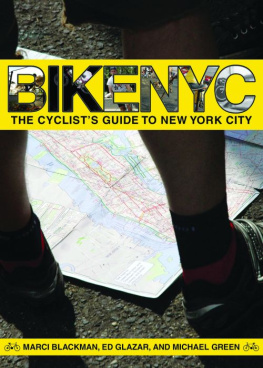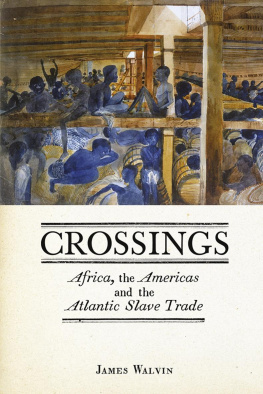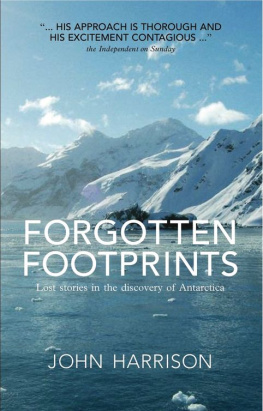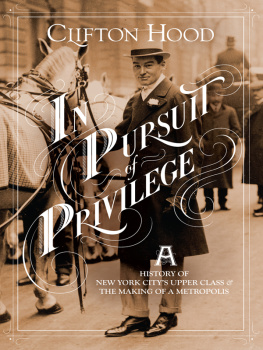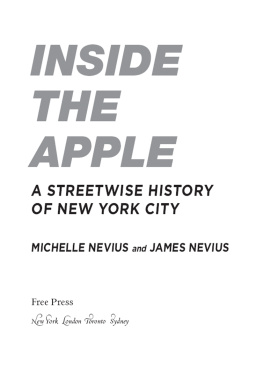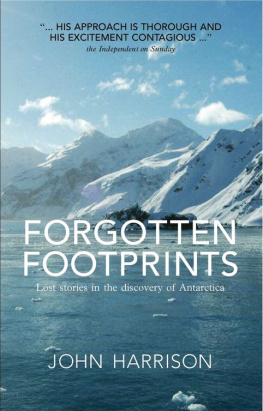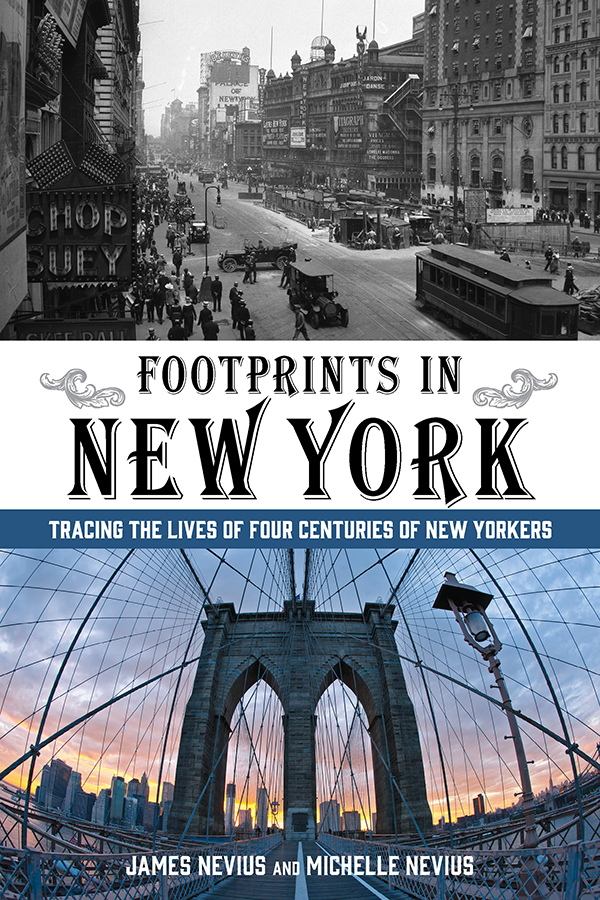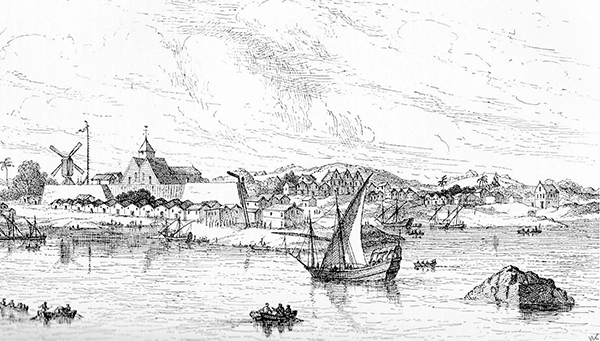Footprints in New York
Tracing the Lives of Four Centuries of New Yorkers
James Nevius and Michelle Nevius
LYONS PRESS
Guilford, Connecticut
An imprint of Globe Pequot Press
Copyright 2014 by James Nevius and Michelle Nevius
ALL RIGHTS RESERVED. No part of this book may be reproduced or transmitted in any form by any means, electronic or mechanical, including photocopying and recording, or by any information storage and retrieval system, except as may be expressly permitted in writing from the publisher. Requests for permission should be addressed to Globe Pequot Press, Attn: Rights and Permissions Department, PO Box 480, Guilford, CT 06437.
Lyons Press is an imprint of Globe Pequot Press.
Maps by Design Maps Inc. Morris Book Publishing, LLC
Project editor: Meredith Dias
Layout: Kirsten Livingston
Library of Congress Cataloging-in-Publication Data
Nevius, James.
Footprints in New York : tracing the lives of four centuries of New Yorkers / James Nevius and Michelle Nevius.
pages cm
Includes bibliographical references and index.
ISBN 978-1-4930-0839-1
1. New York (N.Y.)Biography. 2. New York (N.Y.)History. I. Nevius, Michelle. II. Title.
F128.25.N48 2014
974.7'1dc23
2014001590
To the worlds librarians, without whom this book
and most others
would never have been written
Contents
Preface
The concept of this book is simple: We wanted to build a time machine.
Since our grasp of particle physics is weak, we decided on the next best thing, to tell the story of New York City by having each chapter transport the reader to a distinct historical era, from the Dutch village of New Amsterdam to the modern city of skyscrapers thats been built along the very streets the citys Dutch founders once walked.
As our goal is to, literally, follow in the footsteps of the New Yorkers whove come before us, each chapter is linked to a person (or, sometimes, a group of people) whose story is emblematic of that era. Some peoplelike Edgar Allan Poe and Abraham Lincolnare universally famous. Others, such as Gertrude Tredwell or Stephen DeLancey, will only be familiar to a few. But all of them played an important role in the story of the city.
New York is so chock-full of intriguing sites that its a historians dream. Weve been leading walking tours of the city for nearly fifteen years, and in that time weve searched out forgotten byways and journeyed to unexpected corners of the city. Its those placesfrom the citys oldest house to a small synagogue on a stretch of Broadway that most people dont even know existsthat paint a vivid portrait of New York. We talk about famous sites in these pages too, but we hope that when youre reading about some of the more off-the-beaten-track sites, you may want to seek them out yourself.
The greatest joy of leading tours is the moment when a clientoften someone for whom history has always been dry recitations of names, dates, and battlesmakes that real, personal connection with the city of the past. It can happen in unexpected placesa walk down the streets of Little Italy can evoke childhood memories. Examining gun placements in the old fort in Battery Park can suddenly illuminate the importance of the War of 1812 to someone whod never before been able to get a handle on it. Simply walking from Battery Park to Sohothe same path that Alexander Hamilton walked during the Revolution with his artillery companycan do more to reveal the contours of the war for American independence than any textbook. Its our hope that the New York stories in these pages will uncover some of those hidden histories, too.

This book is the work of two people, but from this point forward, we are writing as a single, first-person I instead of the second-person we. In part, this better reflects that some experiences apply to only one of usfor example, in Chapter 1, it is Jamess ancestor who was New Amsterdams city secretary; later, its Michelle who visits the Plymouth Church in Brooklyn Heights. More often, we are experiencing places together, but rather than switch back and forthor write in a more distant, royal Weweve stuck with a more accessible, approachable I.
A slightly fanciful view of New Amsterdam, ca. 1650.
CHAPTER 1
Shadows of Shadows:
Peter Stuyvesant and the Dutch Frontier
Ive never even heard of Peter Stuyvesant.
Im in the East Village, at St. Marks-in-the-Bowery, one of the citys oldest churches, with a client who has just realized hes standing on Peter Stuyvesants grave. Though the tour Im leading is called Peter Stuyvesants Bowery ( bowery being the English corruption of the Dutch word for farm), the client has just nowan hour into the walkworked up the courage to confess that he doesnt know who Im talking about.
Hes certainly not alone.
Peter Stuyvesant was the longest-serving director-general of New Netherland, the Dutch colony on the American frontier, an area that, at its peak, included parts of Connecticut, New Jersey, and Delaware. Stuyvesant served from 1647 until 1664, when the English stole the place right out from under him. Stuyvesants headquarters were in New Amsterdam, or as it is known today, New York.
The mans wife chastises him. You knowPeg-leg Peter Stuyvesant.
The man keeps shaking his head.
Peg-legged. Hard-nosed. Irascible. Anti-Semitic. Old silver nails. If you have ever read about Stuyvesant, youve likely seen these terms bubble to the surface. He isnt a person, but a cartoon character: Big, Bad Peter Stuyvesant.
Of course, if you live outside the United States, you may be more familiar with Stuyvesants name, but only because hes lent it to a popular brand of cigarette. Emblazoned on the cigarette pack is a regal-looking coat of arms, the cross of St. Andrew topped by a furry little rodent.
That rodent is a beaver and its the reason New Amsterdam existed at all.

Standing in the heart of old New Amsterdamtodays Financial Districttrying to picture what it would have looked like in Peter Stuyvesants time takes a vivid imagination. Not a single architectural artifact remains in Manhattan from the Dutch period. What we have left isnt even ephemeralits shadows of shadows.
Those shadows have spread over my entire life. I am a Knickerbockera descendant of one of the settlers of Manhattan. My ancestor was named Johannes Nevius, and he arrived in the colony sometime around 1652 (his first recorded appearance is March 3, 1652, when he served as a witness at a baptism). This was about five years after Stuyvesant had taken over as director-general of New Netherland, and nearly thirty years after the first permanent residents established roots on the island of Manhattan in 1625.
Not long before coming to the New World, Johannes had graduated from the University of Leiden. To indicate his educational status, he styled his namesfirst and lastin Latin. (In Dutch, the name would have been Jan NeeffJohn, the cousin or John, the nephew.)
Presumably, Johannes came to New Amsterdam to make money, though his motivations are lost to us. A history of New York published in 1853 says he was engaged in mercantile pursuits, but that tells us little. Back then, who wasnt?



